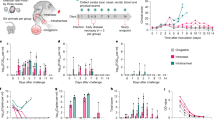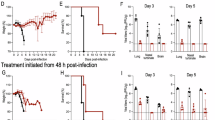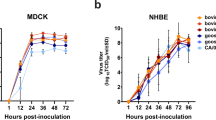Abstract
Testing approved antivirals against A(H5N1) influenza viruses circulating in peridomestic species, including dairy cows, is critical to public health and pre-pandemic planning. It cannot be tested in humans due to A(H5N1) disease severity. Here, in mice, we demonstrate that US FDA-approved baloxavir treatment mediates improved disease outcomes (survival and viral dissemination) over oseltamivir after lethal intranasal and ocular challenge with A(H5N1)-contaminated cow milk.
This is a preview of subscription content, access via your institution
Access options
Access Nature and 54 other Nature Portfolio journals
Get Nature+, our best-value online-access subscription
$32.99 / 30 days
cancel any time
Subscribe to this journal
Receive 12 digital issues and online access to articles
$119.00 per year
only $9.92 per issue
Buy this article
- Purchase on SpringerLink
- Instant access to full article PDF
Prices may be subject to local taxes which are calculated during checkout

Similar content being viewed by others
Data availability
Data generated in this study are provided in the main paper, figures, extended data figures and tables, and in the Source data files. NGS sequence data are available on figshare at https://doi.org/10.6084/m9.figshare.28422422 (ref. 20). Source data are provided with this paper.
Change history
27 March 2025
A Correction to this paper has been published: https://doi.org/10.1038/s41564-025-01994-w
References
Peacock, T. et al. The global H5N1 influenza panzootic in mammals. Nature 637, 304–313 (2025).
Mostafa, A. et al. Avian influenza A (H5N1) virus in dairy cattle: origin, evolution, and cross-species transmission. mBio https://doi.org/10.1128/mbio.02542-24 (2024).
Centers for Disease Control and Prevention CDC Reports Fourth Human Case of H5 Bird Flu Tied to Dairy Cow Outbreak (CDC Newsroom, 2024); https://www.cdc.gov/media/releases/2024/p-0703-4th-human-case-h5.html
Statement from the Public Health Agency of Canada: Update on Avian Influenza and Risk to Canadians (Public Health Agency of Canada, 2024); https://www.canada.ca/en/public-health/news/2024/11/update-on-avian-influenza-and-risk-to-canadians.html
Centers for Disease Control and Prevention First H5 Bird Flu Death Reported in United States (CDC Newsroom, 2025); https://www.cdc.gov/media/releases/2025/m0106-h5-birdflu-death.html
Hayden, F. G. et al. Baloxavir marboxil for uncomplicated influenza in adults and adolescents. N. Engl. J. Med. 379, 913–923 (2018).
Koszalka, P., Subbarao, K. & Baz, M. Preclinical and clinical developments for combination treatment of influenza. PLoS Pathog. 18, e1010481 (2022).
Shinya, K. et al. Systemic dissemination of H5N1 influenza A viruses in ferrets and hamsters after direct intragastric inoculation. J. Virol. 85, 4673–4678 (2011).
Bauer, L., Benavides, F. F. W., Veldhuis Kroeze, E. J. B., de Wit, E. & van Riel, D. The neuropathogenesis of highly pathogenic avian influenza H5Nx viruses in mammalian species including humans. Trends Neurosci. 46, 953–970 (2023).
Guan, L. et al. Cow’s milk containing avian influenza A(H5N1) virus — heat inactivation and infectivity in mice. N. Engl. J. Med. 391, 87–90 (2024).
Fukao, K. et al. Prophylactic treatment with baloxavir protects mice from lethal infection with influenza A and B viruses. Viruses https://doi.org/10.3390/v15112264 (2023).
Taniguchi, K. et al. Characterization of the in vitro and in vivo efficacy of baloxavir marboxil against H5 highly pathogenic avian influenza virus infection. Viruses https://doi.org/10.3390/v14010111 (2022).
Yen, H. L., Monto, A. S., Webster, R. G. & Govorkova, E. A. Virulence may determine the necessary duration and dosage of oseltamivir treatment for highly pathogenic A/Vietnam/1203/04 influenza virus in mice. J. Infect. Dis. 192, 665–672 (2005).
Reed, L. J. & Muench, H. A simple method of estimating fifty percent endpoints. Am. J. Hyg. 27, 493–497 (1938).
Eisfeld, A. J. et al. Pathogenicity and transmissibility of bovine H5N1 influenza virus. Nature 633, 426–432 (2024).
Belser, J. A., Wadford, D. A., Xu, J., Katz, J. M. & Tumpey, T. M. Ocular infection of mice with influenza A (H7) viruses: a site of primary replication and spread to the respiratory tract. J. Virol. 83, 7075–7084 (2009).
WHO Manual on Animal Influenza Diagnosis and Surveillance WHO/CDS/CSR/NCS/2002.5 Rev. 1 (World Health Organization, 2002); https://iris.who.int/bitstream/handle/10665/68026/WHO_CDS_CSR_NCS_2002.5.pdf?sequence=1&isAllowed=y
Potier, M., Mameli, L., Belisle, M., Dallaire, L. & Melancon, S. B. Fluorometric assay of neuraminidase with a sodium (4-methylumbelliferyl-alpha-d-N-acetylneuraminate) substrate. Anal. Biochem. 94, 287–296 (1979).
Patel, M. C. et al. An optimized cell-based assay to assess influenza virus replication by measuring neuraminidase activity and its applications for virological surveillance. Antiviral Res. 208, 105457 (2022).
Jones, J. C. Baloxavir improves disease outcomes in mice after intranasal or ocular infection with Influenza A virus H5N1-contaminated cow’s milk. figshare https://doi.org/10.6084/m9.figshare.28422422 (2025).
Acknowledgements
We thank St Jude Children’s Research Hospital (SJCRH) animal care staff H. Weinberg, C. Stultz and D. Carey, and the SJCRH Hartwell Center for Bioinformatics for assistance with sequence analysis; the SJCRH research staff or faculty P. Seiler, J. DeBeauchamp, J. Fogo, M. Davis and S. L. Schultz-Cherry for helpful discussion of the paper and data. This study was conducted with federal funds from the National Institute of Allergy and Infectious Diseases, National Institutes of Health, Department of Health and Human Services, contract no. 75N93021C00016 (R.J.W.). The content in this manuscript is solely the responsibility of the authors and does not necessarily represent the official views of the National Institutes of Health.
Author information
Authors and Affiliations
Contributions
J.C.J., K.A., E.A.G., A.S.B. and R.J.W. conceptualized the research project. J.C.J., K.A. and T.P.F. acquired and/or analysed the data. J.C.J. and E.A.G. wrote original drafts, and all other authors reviewed and edited subsequent drafts. Funding was acquired by R.J.W.
Corresponding author
Ethics declarations
Competing interests
The authors declare no competing interests.
Peer review
Peer review information
Nature Microbiology thanks Young Ki Choi, Diego Diel and the other, anonymous, reviewer(s) for their contribution to the peer review of this work. Peer reviewer reports are available.
Additional information
Publisher’s note Springer Nature remains neutral with regard to jurisdictional claims in published maps and institutional affiliations.
Extended data
Extended Data Fig. 1 50% Mouse Lethal Dose (MLD50) of A/bovine/Ohio/B24OSU-439/2024 contaminated milk administered by multiple routes.
Mice (n = 3 or 4 per dilution) were inoculated with the indicated virus-contaminated milk dose in total volume of 50 μL (oral), 30 μL (intranasal), or 10 μL (ocular, 5 μL/eye). Survival was monitored for 14 days post-inoculation. MLD50 values were estimated by method of Reed and Meunch14. Mock inoculated animals received an equal dose of influenza A, M gene real-time PCR negative milk (Ct ≥ 36). The full dilution series was not used for each route.
Extended Data Fig. 2 Effects of OSE and BXA on morbidity in mice inoculated with A/bovine/Ohio/B24OSU-439/2024 contaminated milk.
Mice (n = 8/survival group) were inoculated by the indicated route and treated with OSE or BXA as indicated beginning 24 hpi. Animals were weighed daily to assess morbidity.
Supplementary information
Source data
Source Data Fig. 1
Individual source data, divided into tabs, for main figures/tables and extended figures.
Rights and permissions
Springer Nature or its licensor (e.g. a society or other partner) holds exclusive rights to this article under a publishing agreement with the author(s) or other rightsholder(s); author self-archiving of the accepted manuscript version of this article is solely governed by the terms of such publishing agreement and applicable law.
About this article
Cite this article
Jones, J.C., Andreev, K., Fabrizio, T.P. et al. Baloxavir improves disease outcomes in mice after intranasal or ocular infection with Influenza A virus H5N1-contaminated cow’s milk. Nat Microbiol 10, 836–840 (2025). https://doi.org/10.1038/s41564-025-01961-5
Received:
Accepted:
Published:
Issue date:
DOI: https://doi.org/10.1038/s41564-025-01961-5



